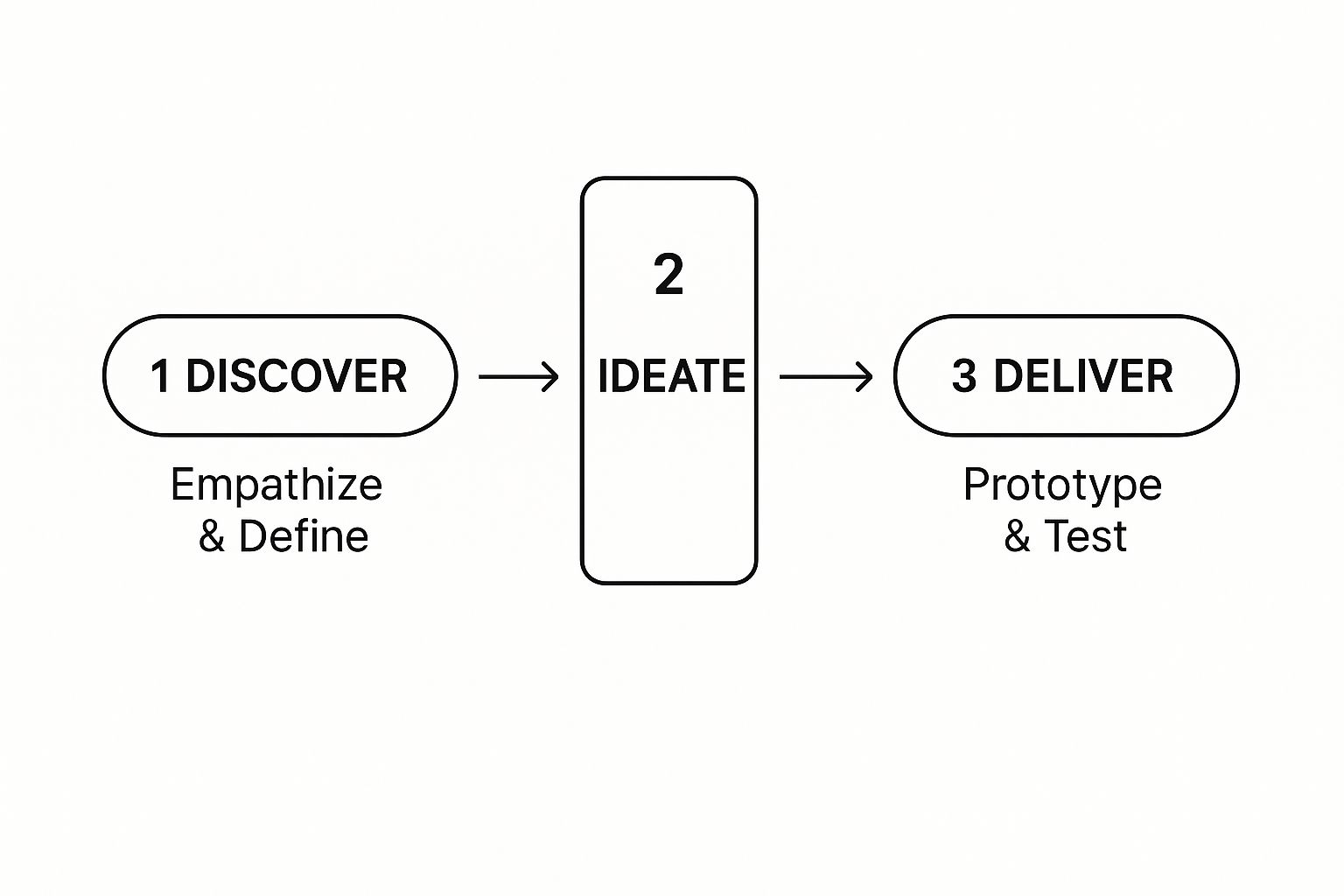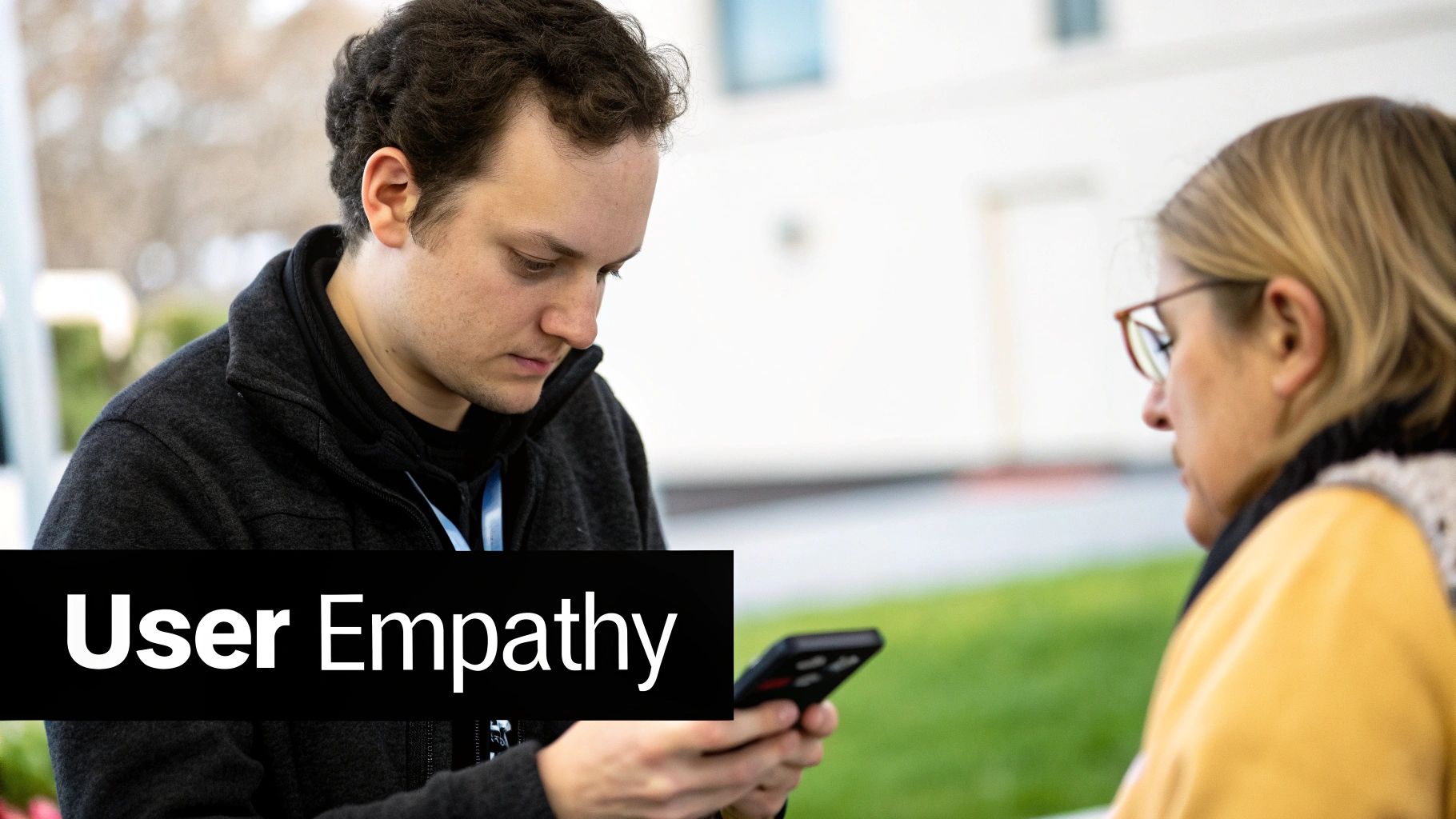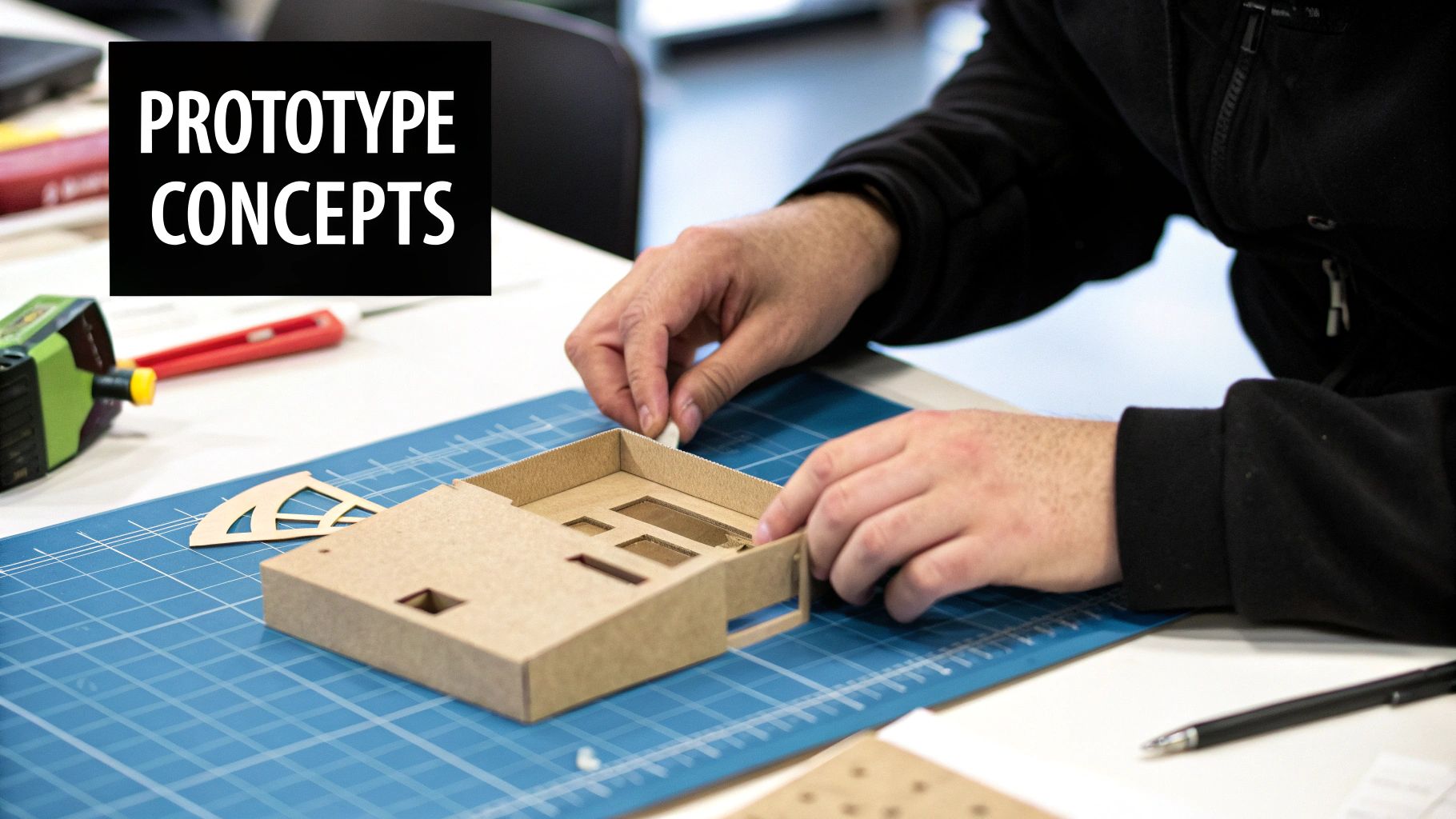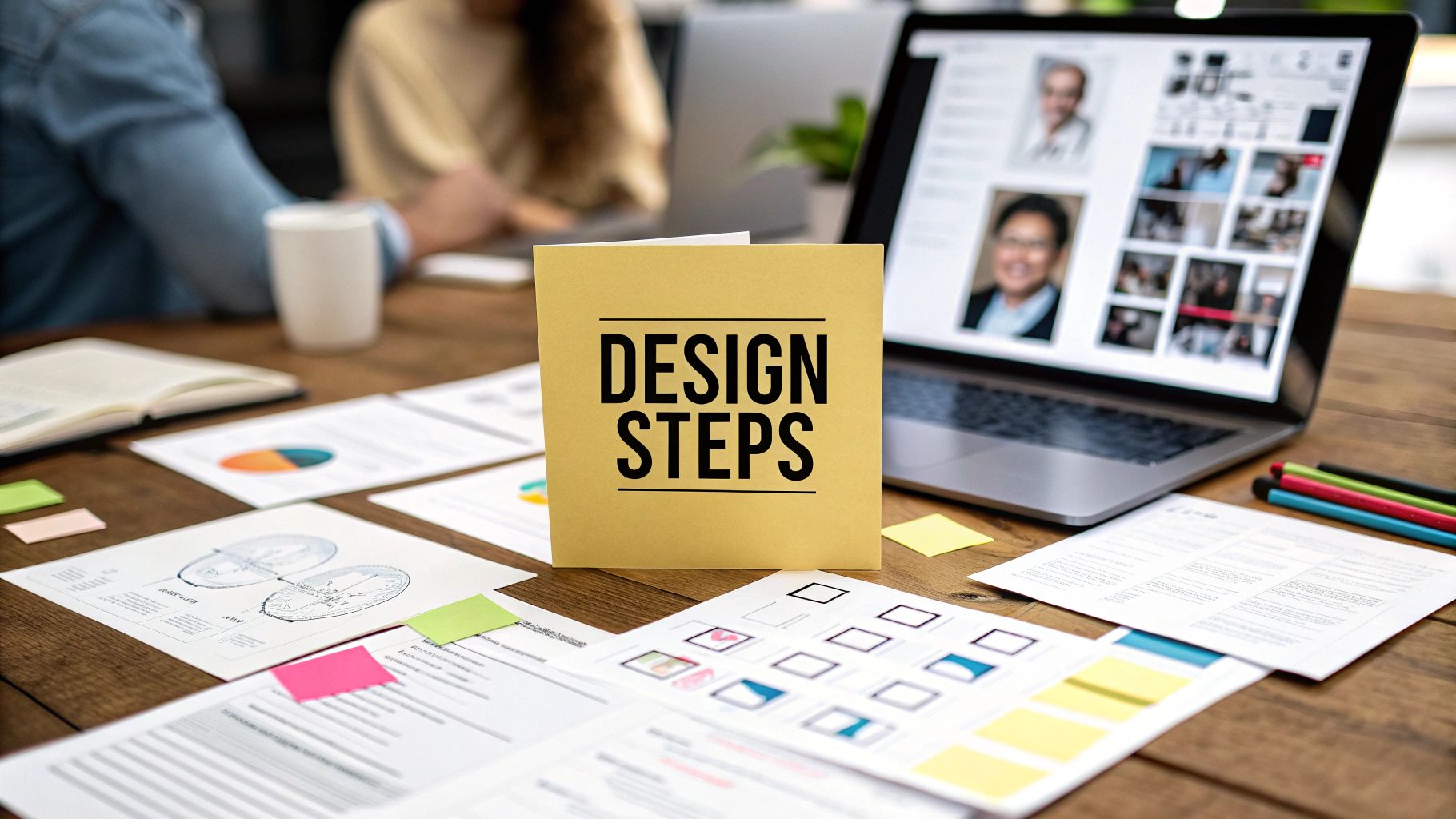The design thinking process is really a framework for getting to the heart of a problem by focusing on the people experiencing it. It’s broken down into five core stages: Empathize, Define, Ideate, Prototype, and Test. Think of it less as a rigid checklist and more as a flexible, human-centered approach to solving tricky challenges.
Putting People at the Heart of Problem Solving
Design thinking is more than just a process; it's a complete shift in mindset. It forces you to move away from making assumptions and instead prioritize understanding the very people you're trying to help. This philosophy is all about building things that people actually want and will find genuinely useful. It’s also iterative, which is just a fancy way of saying you’ll often loop back to earlier stages as you learn more.
A Flexible Framework for Innovation
While we often see design thinking laid out as five neat steps, the reality is much more fluid. Its rise in popularity owes a lot to trailblazers like IDEO and Stanford's d.school. Back in the 2000s, they championed a formal method built on empathy, wild brainstorming, and quick, scrappy experiments. You can discover more about the history of design thinking to see how these core ideas came together.
The image below gives a great visual breakdown of how the process flows, from initial discovery all the way to delivering a solution.

You can see how everything starts with understanding people's needs, which then fuels the ideas that eventually become tangible products or services.
The real goal isn't to follow these steps perfectly in order. It's about using them as a guide. It's completely normal to test a prototype, learn something new, and find yourself jumping right back to the Define stage to sharpen your problem statement.
The 5 Design Thinking Stages at a Glance
Before we dig into the details of each phase, here's a quick cheat sheet. This table summarizes the five stages, their main goals, and the kinds of activities you'll be doing. It's a great reference to keep handy as we go.
With that overview in mind, let's dive into what each of these stages looks like in practice.
Step 1: Developing Real Empathy for Your Users
Every great solution begins with a simple, human-to-human connection. The Empathize phase is all about stepping into your user's world, leaving your own assumptions at the door to see problems through their eyes. This isn't just a preliminary step; it's the bedrock of the entire design thinking process.

This intense focus on the user is what makes the five-stage model so powerful. It ensures that whatever you build is grounded in real human needs, not just what you think they need.
Going Beyond Surface-Level Feedback
True empathy means digging deeper than "What do you want?" It’s about being genuinely curious about your users' motivations, their daily frustrations, and the world they live in. Before you can solve their problem, you need to understand who they are. If you haven't nailed this down yet, our guide on how to find your target audience is a great place to start.
To really get to the heart of their needs, you'll want to get comfortable with essential user research methods that uncover what people do, not just what they say. These techniques are your toolkit for gathering rich, qualitative insights.
Imagine a team working on a mobile banking app. Instead of just asking, "What features are missing?" they watch people actually manage their finances. They ask open-ended questions like, "Walk me through how you paid your bills last month." This subtle shift in approach can reveal so much more.
This method gets you past simple feature requests and into the core emotional drivers. You might discover the user isn't just confused by the interface; they’re deeply anxious about accidentally overdrawing their account.
This kind of qualitative understanding is pure gold. It’s not about collecting anonymous data points; it's about piecing together the story of your user's experience. This insight becomes the guiding star for every decision you make throughout the design thinking process.
Defining the Problem That Truly Matters
So, you’ve spent time walking in your user’s shoes. What now? The next step in the design thinking process is to make sense of everything you've gathered. The Define stage is all about turning that mountain of interviews, notes, and observations into a single, focused problem statement.
This isn't the time to talk about business goals or new features. It’s about articulating the real human problem you need to solve.
You'll start by sifting through your research. Look for patterns and surprising insights that keep popping up. Did several people use the word "overwhelmed" when talking about notifications? Did you notice them using a clever workaround to get past a clunky part of your app? These are the golden nuggets you’re looking for.
Think of this stage as a critical pivot. A clearly defined problem acts as a North Star for the entire team, making sure everyone is rowing in the same direction. It’s a lot like the briefing stage in a professional logo design process, where you have to nail the core message before a single sketch is made.
From Vague Pains to Actionable Questions
One of the biggest pitfalls here is creating a problem statement that's too broad or, worse, just a business objective in disguise. "We need to increase app engagement" isn't a user problem; it's a company wish.
To avoid this, we need to synthesize our findings in a more meaningful way. A great way to do this is with user personas—creating a fictional character who represents your ideal user—and empathy maps. These tools help you organize all that rich, qualitative data around a specific person's feelings, thoughts, and needs.
A solid problem statement should be:
- Human-centered: It puts a specific user, not the business, at the core of the challenge.
- Broad enough for creativity: It shouldn't box you into one specific solution.
- Narrow enough to be manageable: It gives you clear boundaries to work within.
The magic really happens when you reframe the problem as an opportunity. We do this by turning the statement into a “How Might We” (HMW) question. This simple tweak kicks off optimistic, solution-oriented thinking.
Let’s go back to the banking app example. A user might vaguely say, "the app is confusing." After digging in, you might define the problem more sharply. The resulting HMW question could become: "How might we help busy professionals feel more in control of their monthly budget?"
See the difference? This question is inspiring, actionable, and laser-focused. It perfectly sets your team up for the next stage: Ideation.
3. Ideate: Let the Creative Ideas Flow
You've done the hard work of understanding your users and have a crystal-clear problem statement. Now comes the fun part—the Ideate phase. This is where you and your team get to be expansive and a little wild.
Think of it as a creative free-for-all. The goal here is simple: quantity over quality. You want to generate a massive list of potential solutions without any judgment. Seriously, no idea is a bad idea at this stage.

This is where having a team with different backgrounds and skills really pays off. Diverse perspectives are the secret ingredient to true innovation. Encourage everyone to think outside the box and push the boundaries of what seems possible.
How to Spark Real Creativity
Sometimes just saying "Okay, brainstorm!" isn't enough. You need structured exercises to get people past their initial mental blocks and challenge their assumptions. I've found a few methods to be incredibly effective in my own sessions:
- Mind Mapping: Grab a whiteboard (or a virtual one) and put your problem statement right in the middle. From there, just start branching out with any related thought or idea that comes to mind. It creates a great visual map of your collective brainpower.
- SCAMPER: This is a fantastic creative checklist. You force yourselves to look at the problem through different lenses: Substitute, Combine, Adapt, Modify, Put to another use, Eliminate, and Reverse. It’s a surefire way to get unstuck.
- Worst Possible Idea: This one is my personal favorite. Ask the team to brainstorm the absolute worst, most ridiculous solutions imaginable. It instantly lowers the pressure, gets people laughing, and funny enough, the opposite of a terrible idea is often a brilliant one.
For that banking app team we mentioned, this phase could get really interesting. They might come up with anything from a gamified savings challenge with a social leaderboard to an AI financial advisor that talks like a pirate. You never know where that golden nugget of an idea is hiding.
The golden rule of ideation is simple: defer judgment. Don't shoot anything down. Just capture every single thought, no matter how small, silly, or ambitious it seems.
Especially with teams working from different places, running effective virtual brainstorming sessions is a skill you'll want to master to keep the creative energy high.
Your objective is to create a huge pool of concepts to draw from. Once the team feels like they’ve explored every possible avenue, you can start to sift through, combine, and polish the most promising ideas. Those are the ones you'll take into the next phase: Prototyping.
Building Prototypes to Learn and Iterate Quickly
Ideas are just theories until you get them in front of real people. This is where your concepts get real, fast. The Prototyping and Testing phases of design thinking work together in a powerful, rapid learning cycle. An idea is just a thought, but a prototype is an experiment built to answer a specific question.

It's important to remember that a prototype is not a finished product. Not even close. It’s a low-cost, tangible version of your idea that you can use to learn as quickly as possible. When you build something real, even if it's just paper and tape, your concept becomes less abstract and much easier for people to react to.
Choosing the Right Fidelity
The secret to effective prototyping is matching your prototype's complexity—its fidelity—to what you need to learn. You don't need a pixel-perfect design to test a basic user journey.
- Low-Fidelity Prototypes: These are your quick and dirty versions. Think paper mockups, storyboards, or simple digital wireframes. They are perfect for testing core concepts and user flows without getting hung up on visual details. For our banking app example, a few paper sketches could instantly tell us if users understand the new budgeting layout.
- High-Fidelity Prototypes: These are much more detailed and interactive, often built with tools like Figma or Adobe XD. They look and feel a lot like the final product, which makes them great for testing usability and getting feedback on visual design and micro-interactions. A clickable prototype of our banking app would let us watch how users actually try to categorize a transaction.
The goal of prototyping is not to create a polished product. It is to build just enough of a concept to get meaningful feedback, helping you learn what works and what doesn't before investing significant time and money.
Once you have a prototype, you test it with real users. Your job is to observe them, listen to their feedback, and pinpoint exactly where they get stuck or confused. This isn't about defending your idea; it's about learning from their experience.
This build-test-learn loop is a massive advantage. In fact, teams that embrace prototyping often see a 50% reduction in time to market compared to older development methods. This same iterative spirit is also essential when you create brand guidelines, ensuring the final identity is tested and proven. This cycle of building, testing, and learning saves countless resources by catching flaws early on.
Common Questions About Design Thinking, Answered
As you start to get your hands dirty with the design thinking process, a few practical questions always seem to pop up. Let’s clear the air on some of the most common ones I hear from teams who are just getting started.
Is the Process Really a Straight Line?
That's probably the biggest question people have. And the answer is a firm no. We teach it as a clean, step-by-step sequence because it’s easier to learn that way, but real-world projects are rarely so neat.
It’s far more common to bounce between the stages. A surprising insight from the Test phase might send you right back to the Define stage to rethink the entire problem. Or, you might realize during prototyping that you need to go all the way back to Empathize because you missed a key user need.
Think of the design thinking stages as a flexible toolkit, not a rigid recipe. The real goal is solving the user's problem, not just checking boxes on a diagram.
Does This Only Work for Designers?
Not at all. You absolutely do not need "designer" in your job title to use this framework. At its core, design thinking is just a structured way for people to solve problems together. It’s incredibly effective for teams in marketing, HR, software development, you name it.
The principles behind it are universal and valuable for any role:
- Empathy: Genuinely understanding the person you're solving a problem for.
- Collaboration: Working with people from different backgrounds to uncover better ideas.
- Experimentation: Building and testing things quickly to see what works and what doesn't.
You can even start small. Try using the mindset to better understand a challenge your own team is facing or to brainstorm fresh solutions for a persistent business roadblock.
What’s the Biggest Mistake Teams Make?
The most common pitfall I see is teams rushing through the first two stages: Empathize and Define. There’s always this built-in excitement to start brainstorming and building cool prototypes, but jumping ahead is a huge mistake.
If you don't have a deep, empathetic understanding of your user and a sharply defined problem, you’ll just end up building a fantastic solution for the wrong problem. Spending quality time on that foundational work is the single most important thing you can do to get a great result.
Ready to build a brand that truly connects with your audience? Softriver specializes in creating custom brand identities that are built on strategic insight and exceptional design. Start your branding project with us today.







